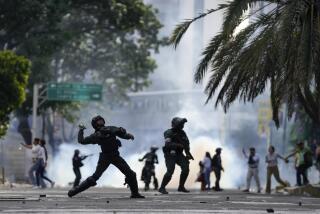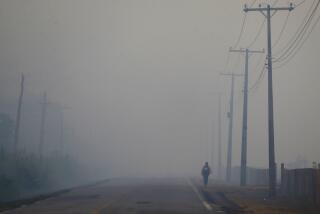Colombia-Panama Plan to Build Rain Forest Road Draws Fire : Latin America: Controversial project would span the 60-mile Darien Gap, the only missing segment in the 16,000-mile Pan-American Highway linking Alaska to Chile. Environmentalists and native peoples object.
BOGOTA, Colombia â Spurred by improved technology, a long-delayed campaign has gained momentum to complete the only missing segment in the 16,000-mile Pan-American Highway linking Alaska to the southern tip of Chile.
The concept of connecting the Americas by road was first proposed in 1929. Ever since, the Darien Gap--60 miles of dense, malaria-infested rain forest and wetlands straddling the Panama-Colombia border--has been an insurmountable engineering obstacle.
Now the problem is environmental, not logistic. Environmentalists are fighting to save this bastion of biodiversity, which forms a natural biological bridge between the Americas.
âThe Darien is a living laboratory and perhaps one of the planetâs epicenters with the most genetic flow,â according to a study by the Biopacific Project, a United Nations-funded organization working under Colombiaâs new environmental ministry.
After a meeting in 1993, Colombia and Panama requested funding from the Inter-American Development Bank for an environmental impact study of a Darien Gap highway.
The bank is deciding on a framework for the study, which could cost $5 million. If the plan is approved, construction could begin within two years, said Guillermo Gaviria, director of Colombiaâs National Institute of Roads.
The proposed $300-million road bisects two national parks--Los Katios in Colombia and Darien in Panama--which are home to several indigenous peoples and form an important transitional zone for flora and fauna.
âWhat weâve perceived to be a threat is not the road itself,â said Marko Ehrlich, an environmental officer with the bank, âbut the unregulated slash-and-burn advance that might occur once the area is opened.â
Before the bank will provide any funds, he said, the two countries must prove they can manage the road.
The last big push to bridge the Darien Gap began in 1971, when the United States pledged to finance two-thirds of the projectâs cost. The engineering feat would take 10 years, it was estimated.
Plans were suspended, however, because of pressure from the Sierra Club and other environmental groups. In 1978, to prevent the spread of hoof-and-mouth disease from Colombia to Central America, the Agriculture Department forced a withdrawal of United Statesâ support.
Colombia created the 180,000-acre Los Katios park as a buffer zone to control the cattle disease. In 1991 the Agriculture Department declared the disease eradicated in that area. Plans to complete the highway were revived.
âAmerican commerce, American integration depend on the road,â Colombiaâs transportation minister, Juan Gomez Martinez, said. âThe gap is a disgrace for the Americas.â
Colombia has more reasons than Panama to push for completion. The connection would give Colombia access to the Panama Canal and would increase the flow of tourists, Gaviria said.
It also would facilitate law enforcement in the region, one of Colombiaâs most volatile. Accessible only by the broad Atrato River, which empties into the Caribbean at the Gulf of Uruba, the Darien is a haven for coca growers, drug smugglers and guerrilla groups.
The Darien Gap is so nearly impenetrable that it took a 1972 British military expedition, whose vehicles were the first to cross this remote stretch of jungle, 99 days to drive the 60 miles.
Panama and Colombia each lack about 30 miles of road. Colombiaâs construction plans call for a raised earthen embankment to cross a 13-mile-wide stretch of wetlands, and a bridge, almost a mile in length, to cross the Atrato.
The countries are once again looking for U.S. financial support. At last Decemberâs Summit of the Americas in Miami, Colombiaâs Gomez presented a plan to his U.S. counterpart, Transportation Secretary Federico Pena. Gomez is awaiting a reply.
According to the Biopacific study, building the road would open the rain forest and wetlands to colonists, who would harvest timber and strip the land for cattle ranching.
The environmentalists point to the northernmost 18 miles of Colombiaâs Pan-American Highway, a stretch pieced together between 1979 and 1983. Maps of the surrounding area show more than 60% deforestation, most of it for cattle, between 1970 and 1992.
An alternative to the Darien Gap highway would be a river ferry service between Turbo, Colombia, and one of several sites in Panama.
âAt the moment itâs a good option,â said Juan Pablo Ruiz, director of Ecofondo, another Colombian environmental organization. âWe see how England has been connected with Europe for years with a ferry.â
âI would ask you how many ferries cross rivers in the United States,â scoffed Gaviria.
Some of the strongest opposition to the Darien highway comes from the areaâs indigenous groups--about 8,000 Indians in five tribes. Their leaders have formed a commission that has denounced the construction project.
âWe live off the forest,â said Fabio Chamapuro, a Wounaan Indian who heads OREWA, Colombiaâs main indigenous federation. âAll sustenance we get from the jungle. If they destroy the forest, immediately we are going to suffer the equivalent of genocide.â
Several years ago OREWA blocked another government road project, a proposed highway to the Pacific coastal town of Nuqui, that encroached on the Indiansâ traditional territory southwest of the Darien. If the government continues with its current highway plans, leaders say, the Indians might resort to similar action.
âWhenever they finish a project, the indigenous group that was inhabiting the area no longer wants to be indigenous,â said Chamapuro. âAnd for us this is very dangerous.â
More to Read
Sign up for Essential California
The most important California stories and recommendations in your inbox every morning.
You may occasionally receive promotional content from the Los Angeles Times.










